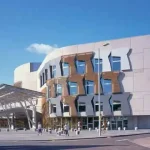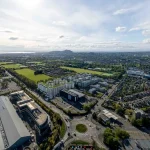Scottish Parliament Building, Views, Appearance, Controversy, David Dimbleby Scotland
Scottish Parliament Reviews: Architecture
Holyrood Building Reviews, Scotland
post updated 30 October 2023
Scottish Parliament Building
News Excerpts re Scottish Parliament Building
Royal Dimbleby
More Carbuncle attacks a la Prince Charles as David Dimbleby in his quaint and soothing TV programme reared up at the end to have a bash at that favourite target the Scottish Parliament. Apparently the exterior looks to him like a ‘spanish airport’ (now who said that previously?) yet my travels in Spain have never revealed any aeropuerto remotely similar, but seriously he liked the inside so that’s fine. He went on to say the building “isn’t very Scottish”, easy to say, but David what exactly is an appropriate contemporary Scottish architectural language and how can you define this?
It’s of course much easier to mock and knock than try and supply answers and David is not alone on the ‘It’s a carbuncle’ bandwagon. A culturally confident country should surely have the balls to question aspects of the building (the awful inception/procurement) in central Edinburgh but see beyond that and understand this most unusual building is from a highly gifted architect and that it will take time to settle in. Aesthetically it doesn’t always melt your heart but the xenophobic references to bus stations and airports are stale and unedifying.
19 Jun 2007
Reviews re Scottish Parliament Building:
In an interview with Building Scotland in Oct 1998 Enric Miralles said of the Scottish Parliament: “It was more of a search for iconography than wanting to build a specific building”.
Influences for the Parliament building reported include upturned boats at Holy Island, flower paintings & Glasgow School of Art by Charles Rennie Mackintosh. Architect influences are noted by Gillespie as Aalto, Kahn, Pietila, Coderch, Lapena & Torres, Viaplana & Pinon.
Louis Kahn was a strong influence on Enric Miralles and the Kimbell Museum’s vaults specifically for the three tapering vaults of the Debating Chamber ground floor.
Holy Island buildings – Scottish Parliament influence – Lindisfarne boat…..just over the border into England
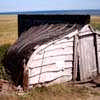
Holy Island Boat – influence: photo © Adrian Welch 2006
Jonathan Glancey described the Scottish Parliament Building in early 2004
as ”a rich, complex and crafted design, as much landscape as architecture, a building that will connect the city centre emotionally and physically to the hills beyond”.
Neil Gillespie in his AJ article of Sep 2004 described the Scottish
Parliament Building as “a building which we should intuitively know and understand. It evokes a landscape, a hyperborean landscape, a FINN land, a White land. It is about the glacier, in the crush and folding of space and form. It is about the birch tree, the girl of the forest, given architectural form in the delicate timber screens to MSP offices. The concrete Canongate wall throws fragments of stone and drawing to its surface like some glacial moraine.
It eschews passing beauty for something more profound and grounded in this territory. It is about a place beyond the restrictive parochial boundaries of Scotland, it is located firmly in a northern territory. This is not an easy landscape, it is the chaos of the moraine, the anxiety of the gorge, the horror of the void, the silence of Munch’s scream”
Hugh Pearman for The Sunday Times, May 23 2004 described the Scottish Parliament Building as “Insanely bespoke, positively willful, but potentially glorious…. I had expected the building to make a big statement in today’s fashionable “signature” style, but to be let down by its details, to wilt under close scrutiny. But the opposite is true….. the quality of the finished work, the level of detailing, is prodigious. It is remarkable to find such a level of individual craftsmanship in a building of this size.”
Clare Wright for the RIBA Journal, Oct 2004 states that the new Scottish Parliament has “surprisingly generous public spaces for alternative views”. The Parliament Building is “so carefully stitched into the refurbished Queensberry House…The Building, on a scale with those around it, is broken up into bits that come together at the politician’s entrance in an ephemeral, udnerstated way – heralding a modest democracy rather than anything more politically bombastic.
This is an organic, non-hierarchical building and in this respect reflects one of the most important changes to society in the 20th and 21st centuries: the growth of the democratic ideal. The competition and design schemes were by Miralles supported by this small Catalan studio, EMBT, with heavyweight help by Edinburgh-based RMJM, with Arup and Davis Langdon.
John Kinsley, Project Architect for the Scottish Parliament Building also in the RIBA Journal, Oct 2004 notes “One of the things the Fraser inquiry has focused on is the relationship between the two offices, RMJM and EMBT, but at project architect level and below the relationship has been very good. We are all good friends.
Now the building has finished EMBT’s office has come over to look at it. They were very impressed. They said that compared to Miralles’s other projects, in Spain, there is a much higher degree of finish at the Scottish Parliament.”
In 1993 the roof of Enric Miralles’ stadium in Huesca, Spain, collapsed
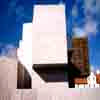
MSP Block south facade, MSP east stair to right © Adrian Welch
Holyrood Inquiry: Scottish Parliament Building
RIAS information 15 Sep 2004
The Holyrood Inquiry: Initial Reaction
The RIAS recognises the key messages of the report by Lord Fraser of Carmyllie QC, published on 15 September. The importance of a clear client strategy and brief, leadership and organisational structure for decision-making; the need to listen to independent consultants, and report their advice; to undertake explicit risk assessments on procurement choices, and tighten up procedures regarding contracts and appointments.
On the architectural side, the RIAS supports the full and transparent recording of all aspects of selection/design competition procedures where a designer – or a design – is being chosen, and a full and rigorous evaluation when linking a Scottish-based practice with a “signature” architect from outwith Scotland.
Despite the difficulties experienced by all parties to this project, it is encouraging that Lord Fraser helped, through the Inquiry, to clarify the extremely demanding job undertaken by the highly talented and committed design team of EMBT/RMJM. The report states that “costs rose because the client wanted increases and changes, or at least approved of them in one manifestation or another”.
The RIAS supported the view that a PFI route should not be pursued if a building of significant architectural merit was to be achieved. It is clear, however, that the risks associated with construction management were not adequately spelled out. The key driving factor was time, and an early start. It appears to the RIAS that one of the fundamental lessons to be learned from the Inquiry is that projects, to be well managed, need time to be developed and honed.
Despite all the criticisms, the commitment of all parties to the Scottish Parliament project are to be commended in seeing it through to completion, and maintaining the quality agenda. That will be the lasting legacy.
Despite the lessons of the Inquiry being a stern reminder of procedures already implicit in best practice guidance in the public sector, the report does not suggest that the industry and its client base should become more risk averse. Opportunities to remain creative and flexible and provide excellent value for money should continue to be grasped by clients of all hues and types. The fact that Scotland is exhibiting at the world’s largest architecture biennale in Venice, demonstrates that the nation has the capability and talent to continue to produce excellent work in an international context.
Scottish Parliament Building – Holyrood Inquiry – RIAS information 15.09.04
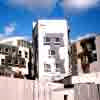
Towers from south-west © Adrian Welch
New Scottish Parliament
“The most significant public building in Scotland’s recent history is taking shape at Holyrood. The new Scottish Parliament building will be as important for Scotland as the Sydney Opera House is for Australia, and Enric Miralles’ exciting design is going to be a tremendous asset for Edinburgh.”
news.scotsman.com
4 January 2002
Scottish Parliament Building Design
Scottish Parliament Building – related posts below:
Scottish Parliament Photographs
Scottish Capital Building Designs
Contemporary Scottish Capital Property Designs – recent architectural selection below:
image courtesy of EHDP
Edinburgh Home Demonstrator Project
Edinburgh World Heritage Status
Scottish Parliament Awards
Scottish Parliament Design Awards
– 2005 RIAS Andrew Doolan Award for Architecture – the UK’s biggest architecture prize
– Mies van der Rohe European Union Prize for Contemporary – Architecture finalist
– Scottish Design Awards 2005 – Best Publicly Funded Building + Architecture Grand Prix
– Civic Trust Awards 2006 Scotland winner
– Manuel de la Dehesa prize
Scottish Parliament Architects: RMJM Scotland
Comments / photos for the Scottish Parliament Edinburgh Architecture Reviews page welcome
